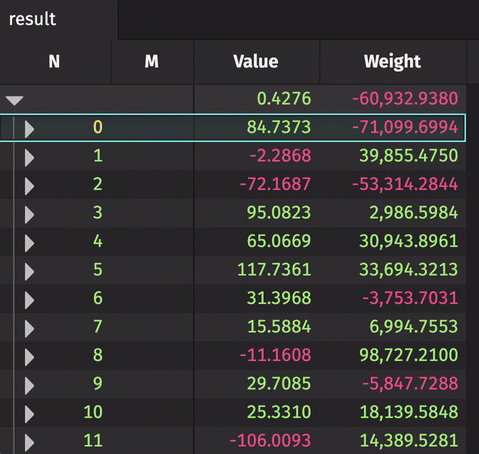rollup
The deephaven rollup method creates a rollup table from a source table given zero or more aggregations and zero or more grouping columns to create a hierarchy from.
Syntax
source.rollup(aggregations)
source.rollup(aggregations, includeConstituents)
source.rollup(aggregations, groupByColumns...)
source.rollup(aggregations, includeConstituents, groupByColumns...)
Parameters
| Parameter | Type | Description |
|---|---|---|
| aggregations | Collection<? extends Aggregation> | One or more aggregations. The following aggregations are supported: |
| includeConstituents optional | boolean | Whether or not to include constituent rows at the leaf level. The default value is |
| groupByColumns | String... | One or more columns to group on and create hierarchy from. |
Methods
Instance
getAggregations- Get the aggregations performed in therollupoperation.getGroupByColumns- Get thegroupByColumnsused for therollupoperation.getLeafNodeType- Get theNodeTypeat the leaf level.getNodeDefinition(nodeType)- Get theTableDefinitionthat should be exposed to node table consumers.includesConstituents- Returns a boolean indicating whether or not the constituent rows at the lowest level are included.makeNodeOperationsRecorder(nodeType)- Get arecorderfor per-node operations to apply during snapshots of the requestedNodeType.translateAggregatedNodeOperationsForConstituentNodes(aggregatedNodeOperationsToTranslate)- Translate node operations for aggregated nodes to the closest equivalent for a constituent node.withFilter(filter)- Create a new rollup table that will apply a filter to the Group By or Constituent columns of the rollup table.withNodeOperations(nodeOperations...)- Create a new rollup table that will apply therecordedoperations to nodes when gathering snapshots.withUpdateView(columns...)- Create a new rollup table that applies a set ofupdateViewoperations to thegroupByColumnsof the rollup table.withNodeOperations(nodeOperations...)- Create a new rollup table that applies therecordedoperations to nodes when gathering snapshots.
Returns
A rollup table.
Examples
The following example creates a rollup table from a source table of insurance expense data. The aggregated average of the bmi and expenses columns are calculated, then the table is rolled up by the region and age column.
import static io.deephaven.csv.CsvTools.readCsv
import io.deephaven.api.agg.spec.AggSpec
import io.deephaven.api.agg.Aggregation
insurance = readCsv("https://media.githubusercontent.com/media/deephaven/examples/main/Insurance/csv/insurance.csv")
aggList = [Aggregation.of(AggSpec.avg(), "bmi", "expenses")]
insuranceRollup = insurance.rollup(aggList, false, "region", "age")
Similar to the previous example, this example creates a rollup table from a source table of insurance expense data. However, this time we are filtering on the source table before applying the rollup using withFilter. Both group and constituent columns can be used in the filter, while aggregation columns cannot.
import static io.deephaven.csv.CsvTools.readCsv
import io.deephaven.api.agg.spec.AggSpec
import io.deephaven.api.agg.Aggregation
import io.deephaven.api.filter.Filter
insurance = readCsv("https://media.githubusercontent.com/media/deephaven/examples/main/Insurance/csv/insurance.csv")
aggList = [Aggregation.of(AggSpec.avg(), "bmi", "expenses")]
filterList = List.of("age > 30")
insuranceRollup = insurance.rollup(aggList, false, "region", "age")
.withFilter(Filter.from(filterList))
The following example creates a rollup table from real-time source data. The source data updates 10,000 times per second. The result rollup table can be expanded by the N column to show unique values of M for each N. The aggregated average and sum are calculated for the Value and Weight, respectively.
import io.deephaven.api.agg.spec.AggSpec
import io.deephaven.api.agg.Aggregation
aggList = [Aggregation.of(AggSpec.avg(), "Value"), Aggregation.of(AggSpec.sum(), "Weight")]
rows = emptyTable(1_000_000).updateView("Group = i", "N = i % 347", "M = i % 29")
changes = timeTable("PT00:00:00.0001").view("Group = i % 1_000_000", "LastModified = Timestamp", "Value = (i * Math.sin(i)) % 6977", "Weight = (i * Math.sin(i)) % 7151").lastBy("Group")
source = rows.join(changes, "Group")
result = source.rollup(aggList, false, "N", "M")
